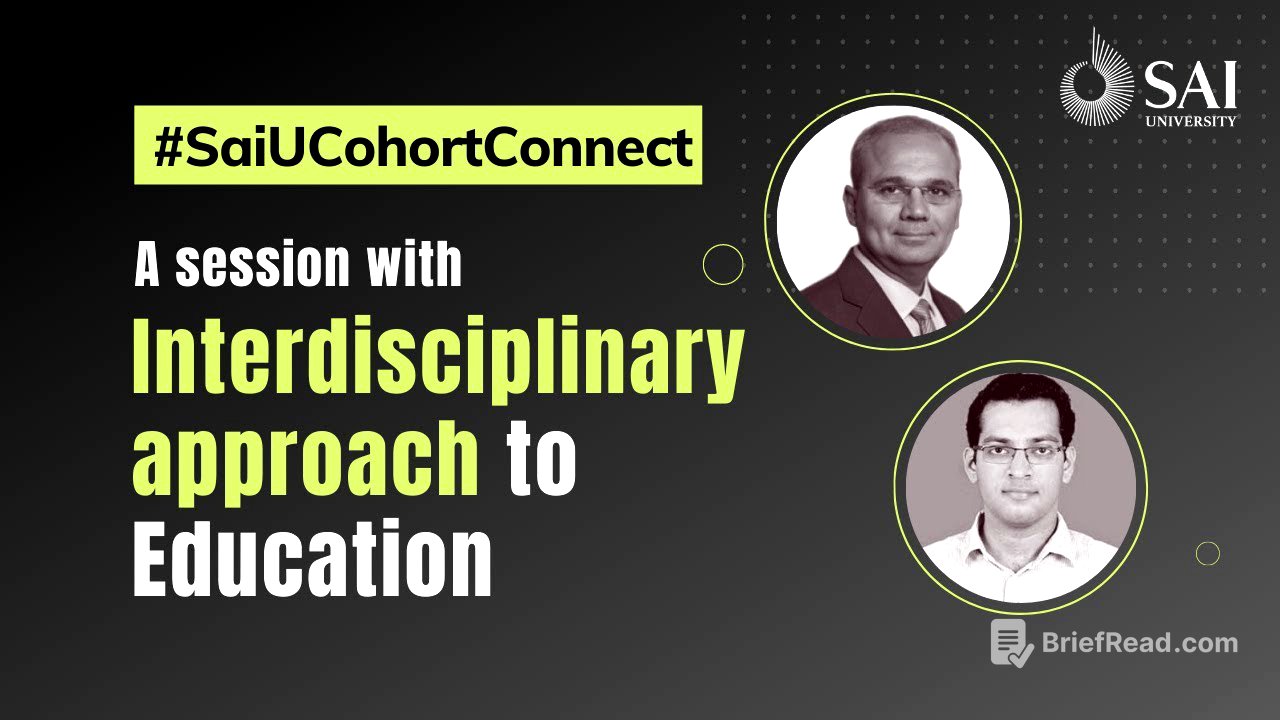TLDR;
Alright folks, here's the gist of the session by Sai University. The talk is all about understanding academic disciplines and why being interdisciplinary is the way to go. Key takeaways include:
- Disciplines have their own concepts and methods, but real-world problems need a mix-and-match approach.
- Interdisciplinarity isn't just about knowing different subjects, it's about creating something new by combining them.
- Breaking down the "tribalism" between disciplines is crucial for a more unified understanding of the world.
Introduction to Sai University and Interdisciplinary Approach [0:08]
The speaker welcomes students to Sai University, highlighting its unique approach inspired by the Harvard model. This model allows students to combine different subjects and disciplines based on their interests, unlike the MIT model which requires a fixed set of courses for a major. Computer science and data science are presented as languages applicable to various fields like economics, music, history, and literature, enabling a deeper understanding through data analysis. The speaker expresses confidence in Sai University becoming a leader in India for this interdisciplinary model, emphasizing India's talent, opportunities, and democratic support for freedoms. The aim is to build a university on par with Ivy League institutions, focusing on quality and character from the start.
Understanding Disciplines and Interdisciplinarity [4:42]
Professor Siddharth leads a session on academic disciplines and interdisciplinarity, encouraging student interaction and intellectual risk-taking. He emphasizes that while specialization is important, a broad base of knowledge is essential at the undergraduate level. Students are encouraged to explore their passions and push faculty to allow mixing and matching of subjects. The goal is to prepare students for a rapidly changing world where critical thinking, broad exposure, and articulate communication are highly valued by employers and postgraduate institutions.
Student Introductions and Backgrounds [10:44]
Professor Siddharth initiates a round of introductions, with students sharing their names, locations, and academic interests. The students come from diverse backgrounds and have varied interests ranging from artificial intelligence and cyber security to literature, psychology, cognitive neuroscience, biology, botany, economics and robotics. This introduction helps to set the stage for a discussion on the importance of interdisciplinarity and how different fields can intersect.
Defining Academic Disciplines: Ontology and Epistemology [18:21]
Professor Siddharth starts by asking students about the differences between academic disciplines they've studied. He introduces the concepts of ontology (the concepts used to describe the world) and epistemology (the methods used to gain knowledge). Disciplines differ not just in what they study, but also in how they carve out domains of human life and the methods they use to gain knowledge. For example, biology and history both study human beings, but biology focuses on biological processes while history examines political and cultural actions.
Social Construction of Disciplines [37:04]
Professor Siddharth explains that disciplines are socially created, housed in university departments, and communicated through books and papers. Disciplines are also regulated by learned societies like the Indian National Science Academy (INSA) and the Indian Council for Historical Research (ICHR), which define what is accepted as science or history. Degrees from universities further solidify this social structure, defining what constitutes scientific knowledge.
Limitations of Disciplinary Frameworks [52:59]
The lecture transitions to discussing the limitations of traditional disciplinary frameworks. These include over-specialization, the failure of real-world problems to fit neatly into disciplinary boxes, and the creation of "silos" that inhibit dialogue between disciplines. The organization of knowledge into disciplines can lead to tribalism, with each discipline developing its own culture, values, and language, creating rivalry and hindering a unified understanding of the world.
The Rise of Interdisciplinarity [1:04:48]
Interdisciplinarity is presented as a solution to the limitations of disciplinary frameworks, involving dialogue, collaboration, and interaction between disciplines at the level of concepts and people. Prominent interdisciplinary fields include energy studies, environmental studies, science and technology studies, and area studies. The motivation for interdisciplinarity stems from the shortcomings of traditional disciplines.
Cognitive Science as an Example of Interdisciplinary Field [1:13:00]
Cognitive science is highlighted as a prime example of an interdisciplinary field, drawing from psychology, computer science (particularly AI), neuroscience, anthropology, linguistics, and philosophy. It studies the human mind and intelligence, addressing how we gain knowledge, understand the world, and act based on that knowledge. Cognitive science emerged from the limitations of individual disciplines and has influenced the development of cognitive psychology and cognitive neuroscience.
Interdisciplinary Challenges Posed by the Pandemic [1:19:52]
The session explores the interdisciplinary challenges posed by the COVID-19 pandemic. Students discuss the need for collaboration between economists, medical doctors, governments, industrialists, and management experts to address issues like affordable healthcare, vaccine production, and distribution. The importance of health informatics, epidemiology, science journalism, psychology, and technology in managing the pandemic is also highlighted.
The Spirit of Interdisciplinarity: Roland Barthes' Quote [1:35:21]
Professor Siddharth shares a quote from Roland Barthes, emphasizing that interdisciplinarity should create something new, beyond the sum of its parts. It's not just about studying different subjects, but forming new concepts and ways to understand the world by putting them together. The goal is to understand the world in a new way, drawing from multiple disciplines.
Hierarchy of Disciplines and Concluding Remarks [1:40:36]
The session concludes with a discussion on the perceived hierarchy of disciplines and the factors that contribute to it, such as job opportunities and economic factors. Students share their views on the value of different disciplines and the importance of interdisciplinary approaches. The professor encourages students to have an open mind and reflect on the social and historical factors that influence how disciplines are structured and perceived. The upcoming open house and September class start date are announced.
